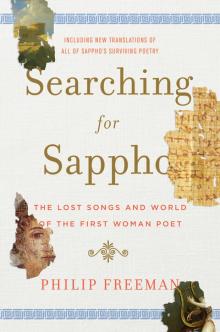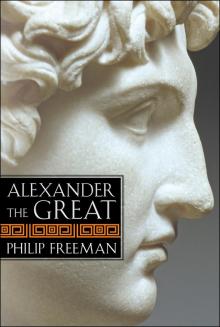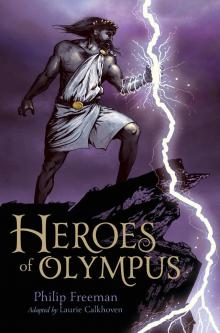- Home
- Philip Freeman
Searching for Sappho Page 3
Searching for Sappho Read online
Page 3
. . . into a deep wave
you jumped from the white horses with mad running.
“I’ve got you, my friend,” I cried. And when you played the tortoise
you leapt out and ran through the garden of the courtyard.
Unhappy Baucis, these are my laments as I weep for you deeply,
these are your footprints resting still warm in my heart, dear girl.
But what we once loved is now gone.
As young girls we held our dolls in our bedrooms
pretending to be new wives, hearts as yet unbroken.
At dawn your mother handed out wool to the servants,
then came in and called you to help with the salted meat.
What terror the monster Mormo brought us when we were girls.
On her head were giant ears and she walked on four legs,
always changing her face.
But when you went to the bed of a man
you forgot all you heard from your mother as a child,
my dear Baucis. Aphrodite filled your heart with forgetfulness.
We could scarcely hope for a more authentic glimpse of a girl’s life in ancient Greece, and indeed the poem is unique. Erinna was one of the few female poets aside from Sappho whose work survives at any length (though barely two pages total in a book). And although Erinna lived three hundred years later, her style, language, and emotional content deliberately echo Sappho. In Erinna’s poem she and Baucis play together on the beach—ancient Greek vases show girls skinny-dipping with one another—and then engage in a game of tag called the “tortoise” around the garden. At a sleepover they play dolls and pretend to be new mothers, and then tell ghost stories about a boogeywoman named Mormo to scare each other. Sappho mentions a similar monster, named Gello, who was once a girl herself but died young and then haunted children, snatching them away to death. At last, as dawn breaks, Baucis’s mother interrupts their fun and comes to call her daughter to work. As the poem ends, Erinna sings:
I weep for you now, absent from your funeral rites,
for my feet may not leave the house and become unclean
nor may I look upon your corpse nor cry with my hair uncovered.
Blood-red shame makes me weep.
Whatever ritually polluting circumstance, perhaps childbirth, keeps Erinna away from the last rites of her childhood friend, she mourns deeply for the friend’s death and the lost innocence they shared as girls. Next to Sappho, no poet gives us a better window into the interior life of a woman in ancient times.
IN ONE OF her poems, Sappho looks back as an old woman on her girlhood days:
my knees that once danced nimbly like fawns cannot carry me
There were surely many occasions for dancing when Sappho was young, but one sort of occasion must have been the religious festivals and rites that girls throughout Greece celebrated at puberty. This was a crucial transition in a girl’s life to mark the time when she set aside childhood things and prepared to take on the task of becoming a wife and mother. It was also a time for the whole community to acknowledge the important role that girls played in religious festivals. For the young women themselves, it was a final chance to form and strengthen bonds of friendship with other girls before the duties and constraints of marriage and children would dominate their lives.
One of the best examples of this sort of religious festival for girls comes from choral songs of the Spartan poet Alcman, who lived in the generation before Sappho. These fragmentary songs were found on papyrus scraps and are known as partheneia, or “maiden songs.” They were performed at a public all-night festival in Sparta that included dancing and racing. The celebration also served as a kind of coming-out party for the girls, who could show themselves off to potential mates and their families. In the first of Alcman’s songs, the girls speak in a single voice in praise of the beauty of their chorus leaders, Hagesichora and Agido. The songs of Alcman are rich in sensual images and homoeroticism, much like the poetry of Sappho:
I sing of the light of Agido.
She is like the sun which she calls
as a witness to shine upon us. Our glorious chorus-leader
does not need me to praise or blame her
in any way, for she shines forth on her own.
She is like a horse set among the grazing herds,
a strong, prize-winning horse with clattering hoofs
as in winged dreams. Do you see her,
like a Venetic race-horse?
But the hair of my cousin Hagesichora gleams
like pure gold.
In another fragment of Alcman, the girls sing of their chorus-leader Astymeloisa as part of a ritual presenting a wreath to Hera, goddess of marriage:
With desire that makes my limbs loose,
she looks upon me more sweetly than sleep or death.
She is not sweet in vain.
Astymeloisa does not answer me,
but holds the wreath
like a star flying through the radiant sky
or like a young golden plant or a soft feather
. . . she moves on slender feet
. . . the moist, delightful perfume Cyprian Cinyras
clings to her virgin hair.
At Athens, there were similar rituals for girls as they grew into women. The Athenian comedy writer Aristophanes includes a key passage in his Lysistrata, a brilliant satire about the women of Greece going on a sex strike to force their husbands to stop a destructive war:
At seven I became Bearer of Secret Things,
then at ten a Grinder for the goddess.
Later at Brauron I was a Bear in a saffron robe,
finally a lovely young Basket-Bearer wearing a string of figs.
Although the setting of the play is comical, there’s little doubt that the sequence of offices here represents a historical reality for at least some girls in ancient Athens. The “Bearers of Secret Things” served at a midsummer night’s festival. Two, or perhaps four, of these bearers were chosen from the aristocratic girls of Athens at the age of seven to live in a dwelling on the north slope of the Acropolis. There for a year they dwelled apart, engaged in sacred ceremonies that are not entirely clear, such as weaving a special garment for the goddess Athena and playing a kind of ballgame. On the appointed summer evening, they carried mysterious items into an underground shrine on the Acropolis and returned with something else, also unnamed, wrapped up. Some ancient writers speculated that these were cakes in the form of snakes or phalluses. In any case, it seems the girls were celebrating a fertility festival based on an ancient myth in which the goddess Athena entrusted a baby to the daughters of the first Athenian king, Cecrops, with instructions not to open the basket. The girls couldn’t resist the temptation, however, and saw inside the snakelike baby, after which they threw themselves off the Acropolis. The girls who were chosen as Bearers of Secret Things were thus selected to reenact a mysterious ritual central to the community because of their gender, young age, social standing, and purity.
We know little of what the “Grinders” did for the goddess aside from the obvious preparation of presumably sacred grain or what the “Basket-Bearers” carried, but the role of young women serving as “Bears” for Artemis is mentioned elsewhere in ancient literature and represented in Athenian art. Athena was a goddess of the civilized urban life of Athens, but Artemis was a huntress who roamed the woods with her nymphs, and her cult was celebrated in the wild countryside over the mountains on the eastern coast of Athenian territory at Brauron. According to the celebration’s origin story, a young girl once teased a bear that in turn attacked her, prompting her brothers to hunt down and slay the animal. Since Artemis was the patron goddess of wild animals, she decreed that she would be appeased only if girls of the city would serve her as bears themselves. Some sources say this role was given only to a select group of girls, but others indicate it was a much wider initiation ritual in which many, if not all, Athenian girls were allowed to participate every few years. Though ta
ntalizingly incomplete, vase paintings of the rituals involved show young women at about the age of puberty running around the sanctuary of the site either nude or wearing saffron-colored skirts.
Since Artemis was a goddess of the transition from girlhood to the adult life of women throughout the ancient Greek world, a celebration similar to this Athenian ritual must have been held for Sappho and her friends on Lesbos. If they were like most Greek girls, they dedicated their toys to the goddess and cut a lock of their hair in symbolic mourning for the end of childhood. The protective goddess Artemis was now left behind as they prepared to enter the new life of active sexuality that was so prominent in the poetry of Sappho—the world of Aphrodite.
2
WEDDING SONGS
Let your bride be four years past puberty and wed her in the fifth.
And be sure to marry a virgin so you can teach her proper ways.
– HESIOD, WORKS AND DAYS
THE BYZANTINE SUDA encyclopedia says that Sappho was married to a wealthy merchant named Cercylas from the Aegean island of Andros. But there is good reason for believing this is a dirty joke derived from one of the later Greek comedies that unfairly and unflatteringly portray Sappho as sex crazed. Cercylas is an otherwise unknown name deriving from the Greek word for the male reproductive organ (kerkos). Andros is a real island lying in the sea between Lesbos and Athens, but its name comes from the Greek word for “male.” Therefore, the reference in the Suda was likely a laugh line for the comedy audience claiming that Sappho was wed to “Penis from Man Island.”
Even though this passage is suspect, it’s almost certain that Sappho was married, since the single life was simply not a viable option, especially for a woman, in the ancient Greek world. The social pressures of family and community, as well as the need for children to care for parents in their later years, made marriage a necessity. We also know from Sappho’s own poetry that she bore and raised a daughter—a situation that would have been virtually impossible for a woman alone. Regardless of Sappho’s sexual preferences, she, like every other Greek woman, was expected to marry and bear children. Perhaps tellingly, she never mentions her husband in her surviving poetry, nor does she write any verses of love in his honor. But whatever his true name and however she felt about him, we can be sure that Sappho had a husband for at least part of her early adult life.
We may know little of Sappho’s own married life, but we are fortunate that some of her greatest surviving poetry deals with the subject of marriage itself. Sappho is, in fact, one of our best literary sources on weddings from the early Greek world, and virtually the only window we have into a woman’s view of the sudden and sometimes terrifying transition from maiden to wife.
The poet Hesiod, who lived in the decades before Sappho, said that a man should marry when he was about thirty years old. Later Greek writers agree that midthirties was the upper age limit for a man’s marriage. This was an ideal; some men married as early as their late teens, but the majority of grooms seemed to have taken a wife at the end of their third decade. This delay was practical, allowing a man to establish himself on his farm or in business so that he could provide for his new family. A man’s late thirties was also a time when his father would likely have either retired from active work and handed over the family assets to his son or already have died. If a man did not produce a son until his early thirties and that son waited until his thirties to sire his own offspring, there must have been relatively few paternal grandfathers in ancient Greece.
The age for brides was much younger. In Sappho’s world, there was no such thing as a prolonged adolescence for girls. Hesiod recommended marriage for women four to five years after puberty, which would have made most brides in their midteens. Girls from wealthy families throughout Greece often married even earlier, many in about their twelfth or thirteenth year. The philosophers Plato and Aristotle encouraged families to wait until a young woman was in her late teens, but this recommendation was probably inspired by the unusual Spartan custom of brides delaying marriage until their eighteenth or even twentieth year.
Greek men would thus have been, on average, fifteen years or more older than their teenage brides. Why would the Greeks practice such a custom? There are several possible answers aside from the need for a man to secure his financial future before marriage. First, a young wife was more easily intimidated and controlled by an older husband. Marriage was not a partnership as much as it was a business transaction in which the wife was often only slightly higher in rank than a sturdy ox. The woman held a crucial but decidedly subordinate role in the marriage relationship. It was her job to bear children and manage the household, not to advise her husband. A typical Greek bride would have little experience in life beyond what was necessary for her to cook, weave, clean, and help as required with the harvest. She would have spent little time outside the home and would have known nothing about the larger world, except what she managed to overhear from her father and brothers. Life for a wealthy girl, such as Sappho, would have offered more opportunities, but in the end a young bride, rich or poor, was a piece of property to be controlled, by harsh measures if necessary.
Another reason for a woman’s early marriage was the all-important role of bridal virginity. A man had to know for certain that his wife’s sons and thus his heirs were his own. To delay a young woman’s age of marriage was to risk the loss of her virginity to another man, in spite of the dreadful consequences such an act would have for her and her family. Under such circumstances, fathers and mothers must have been as eager as any potential husbands for their daughters to marry at an early age. It was also widely believed in the ancient world that a woman’s best childbearing years occurred soon after puberty. Men, by contrast, were thought to have stronger seed when they were older. The fact that many young women died in childbirth because of their physical immaturity seems to have only encouraged the belief that sooner for women was better. If labor and delivery were hard for a teenager, the reasoning went, then it could only grow more difficult as a woman aged.
A final reason why girls were encouraged to marry early was the belief that unmarried girls after puberty were at greater risk for physical and mental instability. A Hippocratic treatise on illnesses affecting virgins states that unmarried young women were prone to disturbing visions and even suicide because the orifice for their menstrual flow had not been properly opened by intercourse with a man. The ancient prescription was simple: frequent sex with a husband and hopefully a resulting pregnancy, which would further aid in achieving balance in both her mind and body.
It’s tempting to see the emphasis on bridal virginity simply as a form of masculine oppression against young women, lest they dare to enjoy their own sexuality and thus reduce their value as a commodity for a future husband, but there is more to the story. The evidence we have from Homer, from other archaic Greek poetry, and, most important, from Sappho suggests that women themselves guarded their virginity as a form of empowerment. In Homer’s Odyssey, the wandering hero Odysseus washes ashore on the island of the Phaeacians and finds there on the beach a beautiful and clever princess named Nausicaa, who is struck by the handsome stranger and sees him as possible husband material. Odysseus tries to win her favor, but Nausicaa is careful to let Odysseus know that, as much as she finds him appealing, she is not about to endanger her reputation, let alone sacrifice her virginity to him there on the shore:
I’m afraid of the insolent men in our community who might mock us and of what the worst sort might say if they see us together. . . . They would speak and that would be a scandal against me. I myself would quite disapprove of a girl who acted so.
Nausicaa insists that Odysseus make his own way to her parents’ home and present himself properly before he has any further contact with her.
In a seduction poem by Archilochus, the poet writes a satire against his ex-girlfriend Neoboule, defaming her reputation as a young woman who offered up her most intimate charms to him before marriage. He did this in revenge after
her father abruptly broke off his engagement to her. The story that she killed herself in shame is possibly fictional, but the reality of a girl’s life being destroyed by even the suggestion of premarital sex with a man was quite real. In the poem, Archilochus delights in seducing another young woman, who seems to be Neoboule’s maiden sister, as part of his vengeance against her family:
“Don’t refuse me dear . . .
Let some other man have Neoboule,
she’s over-ripe anyway.
Her virgin bloom has faded away
along with her charm.
She couldn’t get enough, you know . . .”
I said such things, and taking the girl
I laid her down, wrapped in a soft cloak,
in the blooming flowers,
my arms embracing her neck.
She was still with fear like a fawn.
I gently took her breasts in my hands,
her fresh skin showed the bloom of youth.
Feeling over her whole body,
I released my vital force,
just touching her golden hair.
We should perhaps understand that the seducer did not actually penetrate the maiden before he released his “vital force,” but her reputation was destroyed in any case. Her bloom, her flower—a common metaphor for virginity in Greek poetry—had now withered in the eyes of any other man, and her value as a wife was ruined. It’s hard to imagine a more vicious act of revenge in the ancient Greek world.
The dangers to a young woman’s virtue were ever present. In a play by the Athenian poet Aeschylus, a father warns his daughters:
I urge you not to slip and fall, my dears.
Remember that you’ve now attained
the tempting age that turns the heads of men.

 Searching for Sappho
Searching for Sappho Saint Brigid's Bones
Saint Brigid's Bones Alexander the Great
Alexander the Great Heroes of Olympus
Heroes of Olympus Sacrifice
Sacrifice